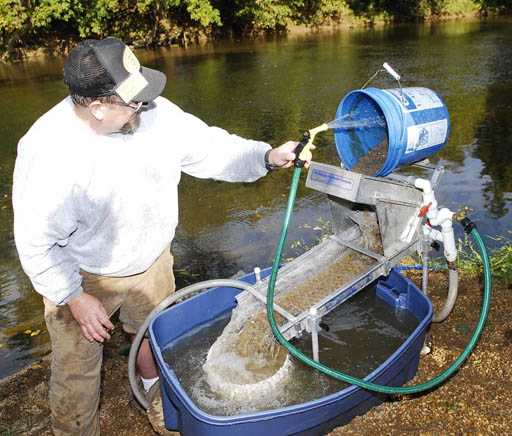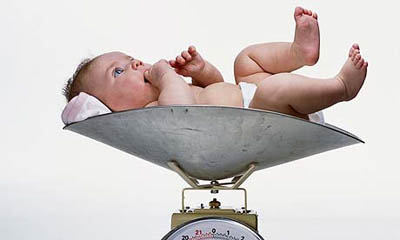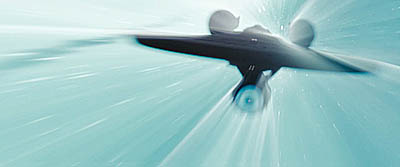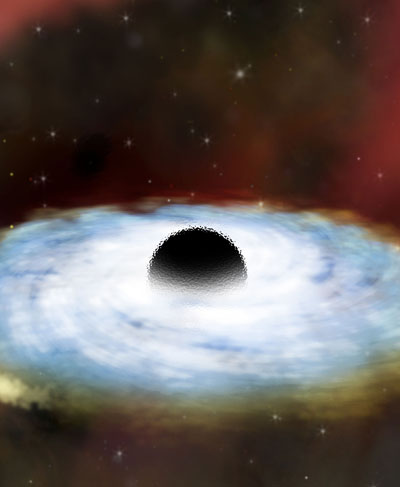TEXTBOOK READINGS |
|
Uncertainty in Measurement & precision/accuracy
This section in the textbook talks about the difference between measurements that have good precision versus those that have good accuracy or those that have neither or both.
|
Author: Zumdahl
6th Edition: pages 11-14
7th Edition: pages 10-13
8th Edition:
pages 11-14 |
Author: Tro
2nd Edition: pages 25-26
|
|
Classification of Matter
This section in the textbook talks about the how to determine if a sample is a mixture, solution, compound, or element.
In the picture, the guy is using a sluice to separate gold from a mixture of sand and water.
|
Author: Zumdahl
6th Edition: pages 26-30
7th Edition: pages 25-28
8th Edition: pages 26 -29 |
Author: Tro
2nd Edition: pages 5-8 |
Problems below are derived from the problems in the back of chapter 1 in Zumdahl's and Tro's books. These problems are viewed here, so you don't need to find them in your textbook. I've also made some variations to the problems. |
|
Problem 1: Baby weight and height: |
| Congratulations! You and your spouse are proud parents of a new baby, born while you are studying in a country that uses the metric system. The nurse has informed you that the baby weighs 3.91 kg and measures 51.4 cm. Convert your baby's weight to pounds and ounces and her length to inches (rounded to the nearest quarter inch). |
|
Problem 2: Star Trek warp speed |
Science fiction often uses nautical analogies to describe space travel. If the starship U.S.S. Enterprise is traveling at warp speed 1.71 (equivalent to 5 times the speed of light), what is its speed in knots and miles per hour? br />
(Below I have a spreadsheet style table that shows how you can set up the conversion. The conversion factors to go from meters per second to knots and from meters per second to miles/hr was looked up at this website: http://www.onlineconversion.com/ Notice that meters/sec cancels)
| |
A |
B |
C |
D |
E |
F |
G |
H |
| |
1.7 warp speed |
Conversion factors |
|
New Speed |
| 1 |
5 times |
speed of light |
meters/sec >> knots |
|
|
|
| 2 |
5.00 |
=3.00*10^8 |
meters/sec |
1 |
knots |
= |
??? |
knots |
| 3 |
|
|
|
0.5144 |
meters/sec |
|
|
|
| 4 |
|
|
|
|
|
|
|
|
| 5 |
5 times |
speed of light |
meters/sec >> mile/hr |
|
|
|
| 6 |
5.00 |
=3.00*10^8 |
meters/sec |
1 |
miles/hr |
= |
??? |
miles/hr |
| 7 |
|
|
|
0.44704 |
meters/sec |
|
|
|
|
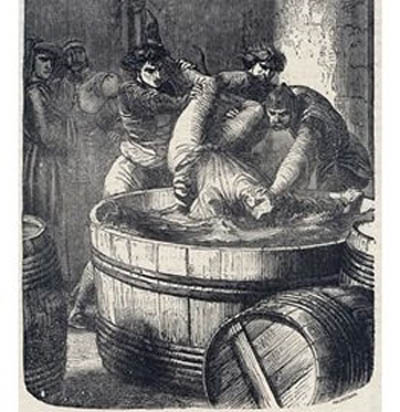 |
Problem 3: Shakespeare's Malmsey Butt: |
In Shakespeare's Richard III, the First Murderer says: "Take that, and that! [Stabs Clarence] If that is not enough, I'll drown you in a malmsey butt within!"
Given that 1 butt = 126 gallons, how many liters of malmsey (a foul brew similar to mead) was the unfortunate Clarence about to be drowned? |
|
Problem 4: Density problem: |
In 1999 scientists discovered a new class of black holes that with masses 100 to 10,000 times the mass of our sun, but occupying less space than our moon. Suppose that one of these black holes has the mass of 1.0 x 103 (one thousand) suns and a radius equal to one-half the radius of our moon. What is the density of the black hole in g/cm3? The radius of our sun is 7.0x105km and it has an average density of 1.4 x 103 kg/m3. The diameter of the moon is 2.16 x 103 miles.
When confronted with a problem like this, don't expect to know how to do it right away. It takes some time for it to sink in. They are asking for density and the general formula of density is mass divided by volume. So the calculations will be to find the mass and the volume of the black hole. A complication is that the measurements are in the Metrics and English systems. The radius of the sun and and diameter of the moon are given, but we will need their volumes (note: Below I divide the moon's diameter by 2, to get its radius). To do that we need the formula for a sphere. It's not given, but you could look it up; however, I'll give it here. The volume of a sphere has the formula of V=4/3πr3. You should try to work out the problem on your own. If you get stuck, you might find the spreadsheet below helpful. |
Knowing density and volume, you can get mass. Knowing density and mass, you can get volume. Here we are given density of the sun plus data to find its volume. That will give us the mass of the sun and therefore the mass of the black hole. Notice I enter the radius of the sun (7.0x105) in a way that a spreadsheet will calculate that value. The "x" is always an asterisk (*) in spreadsheets and some calculators. The exponent is indicated with a caret (^). The equal sign (=) out front signals the spreadsheet program that the following is to be calculated. When the radius gets cubed so does the kilometers. So we end up with kilo cubed and meters cubed. Later you see I have to cancel out the kilo prefixes from both the cubing of kilometer and from the kilograms given. (hint: the answer is more than a billion grams per mL. That's how it can trap light with its gravity).
| |
|
B |
C |
D |
E |
F |
G |
H |
I |
J |
K |
L |
| 1 |
Calculations for mass of black hole in grams |
|
|
|
| 2 |
Volume of Sun = 4/3pi x radius cubed |
Volume x Sun's density gives mass |
cancel 4 kilo's |
mass of 1000 suns |
|
Mass of black hole in grams (formula is given) |
| 3 |
4/3π |
Radius of Sun cubed |
| 4 |
=4/3 |
=pi() |
=(7.0*10^5)^3 |
km x km x km |
=1.4*10^3 |
kg |
=1000^4 |
=1.0*10^3 |
= |
=A4*B4*C4*E4*G4*H4 |
grams |
| 5 |
|
|
|
|
|
m3 |
kilo4 |
|
|
|
|
| 6 |
|
|
|
|
|
|
|
|
|
|
|
|
| 7 |
Calculations for volume of the Moon in milliliters (mL) |
|
|
| 8 |
Volume of Moon= 4/3pi x radius cubed |
convert cubic miles to cubic kilometers using 1.61km=1mile |
cancel kilos cubed |
convert cubic meters to mL |
|
Volume of the black hole |
| 9 |
4/3π |
half of Radius of Moon cubed |
|
| 10 |
=4/3 |
=pi() |
=(1/2*(2.16*10^3)/2)^3 |
miles x miles x miles |
=(1.61)^3 |
(km)3 |
=1000^3 |
1000000 |
mL |
= |
=A10*B10*C10*E10*G10*H10 |
mL |
| 11 |
|
|
|
|
1 |
mile3 |
kilo3 |
1 |
m3 |
|
|
|
| 12 |
|
|
|
|
|
|
|
|
|
|
|
|
| 13 |
|
|
|
|
|
|
|
|
|
|
Density of black hole in g/mL |
| 14 |
|
|
|
|
|
|
Density = |
Mass (grams) |
|
|
=K4/K10 |
g |
| |
|
|
|
|
|
|
Volume (mL) |
|
|
|
mL |
|
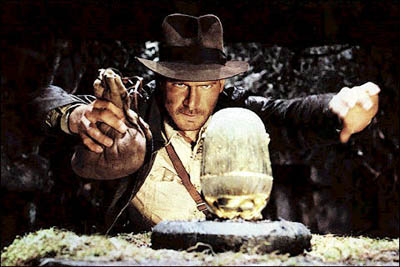 |
Problem 5: Raiders of the Lost Ark: |
In the opening scenes in Raiders of the Lost Ark, Indiana Jones tries to remove a gold idol with a bag of sand of approximate equal volume (Density of gold = 19.3 g/cm3; density of sand = 2 g/cm3.)
a. Did he have a reasonable chance of not activating the mass-sensitive booby trap?
b. In a later scene he and an unscrupulous guide play catch with the idol. Assume that the volume of the idol is about 1.0 L. If it were solid gold, what mass (pounds) would the idol have? Is playing catch with it plausible? |

